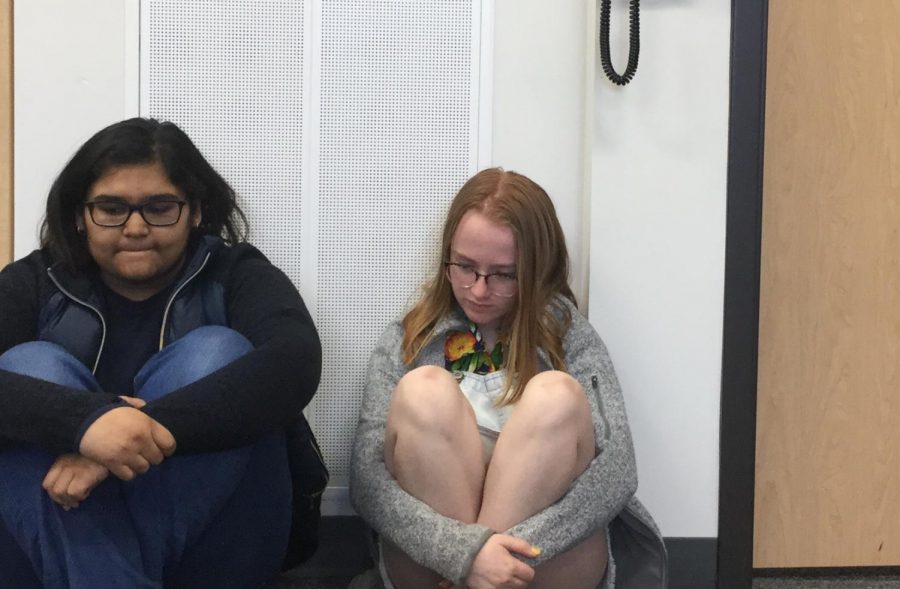How effective are drills, really?
Maryam Mohammed ’21 and Morgan Dunn ’21 demonstrate the current procedure for intruder drills. The school conducts intruder drills by having students sit against the wall and be quiet, out of view of the hall; this is intended to prevent a shooter from realizing that there are potential victims in a room, but the school more or less glosses over what to do if an intruder gains access to a classroom with people.
May 27, 2019
Over the loudspeakers, students are told that a lockdown drill has begun. Teachers lock their doors, turn off the lights, usher their students out of view of the hallway, and tell them to be quiet for the duration of the drill.
The success rate, however, is questionable. More students are quiet than not, but enough students talk that the room cannot be considered silent.
The students who are not quiet do not take the drills seriously. The odds are low that a shooting happens, but low does not mean impossible. Five minutes should not be too long to be quiet. Five minutes should not be too long to pretend, just for a moment, that it is not a drill.
If someone acknowledges that being quiet is imperative during an actual shooting but disregards silence during a drill, which transfers over when it is real? Is the mere understanding of what to do enough?
Many people do not think so; adrenaline and stress interfere with logic. Even if there is a plan in place, the instinct to fight or flee is prone to take over. It is impossible to know for certain how well someone handles themselves without having been in a high-stress situation before. While teachers have been given extensive training on what to do in an active shooter situation, including drills with real firearms loaded with blanks, there have been no similar drills for students. During drills, all students do is hide out of sight of someone in the hallway and talk about plans of what do to if it were real.
“Some students just take drills more seriously than others,” math teacher Steve Smith said. “I would say that it is a spectrum, really. I see a lot of people react very differently, and it is impossible to tell for sure how one person reacts unless it actually happens.”
In a real situation, a spectrum of maturity is not enough. People who are injured in a shooting are injured because the intruder shot at them, which requires knowledge of where people are. That requires the shooter to be tipped off, whether visually or audially, that someone is there. That means that if a shooter is walking by a classroom, a noise from within the classroom could (and is the most likely thing to) be the difference between a shooter entering a classroom and walking past. In such a scenario, a spectrum of maturity is not good enough. All it takes is one person who refuses to take the situation seriously to tip off an intruder.
This ties in to the logic that the school follows with intruder drills. One intruder drill per year is required, but the definition of ‘intruder drill’ is left vague. It is up to the school to decide how they conduct their intruder drill. “Fire drills and tornado drills are fairly cut-and-dry,” principal Ryan Woods said. “They are the same thing every time.”
“Intruder drills are different,” Woods said. “They have a lot of variables that are out of our control. Every shooting is different… our goal is to prepare our staff and students to react to different situations, rather than have a specific procedure.”
This inability to accurately simulate shooter drills is reflected in the lack of active shooter drills. Neither students nor teachers underwent any this year, and that is with good reason. Last year, the drills proved to be a lot to handle. While many teachers handled the scenarios well enough, several teachers had nightmares. If this is the result for the people who are meant to guide students, are entrusted to and held responsible for keeping them safe in emergencies, then the possibility of students reacting worse than the teachers did is too high. The school will not risk any impact on a student’s mental health, however permanent or temporary, and they are as justified, valid, and rational in their decision as they can be.
However – and there is always a ‘however’ – the school’s alternative is simply not enough. The school believes that talking through scenarios, discussing what to do and how to react, is enough to prepare for such an event. The military does not prepare their soldiers for combat based on theory alone; their soldiers go through rigorous training to learn how to follow orders, keep a level head in all scenarios, and react to changing conditions. The school’s equivalent – active shooter drills – fell flat on its face. In its place, the school has limited but viable options.
The first option is to address the problems of the active shooter drills. Because much of the stress comes from the use of actual weapons fired with blanks, the school could use alternate, clearly harmless weapons. Several shooter drills utilize Nerf weapons. The school could also expose students to how a firearm actually sounds by firing several different types of firearms in controlled, safe conditions where students can hear what it sounds like at various places in the building relative to them, but not be in any danger. While this and the Nerf approach could still trigger anxiety-prone students, there are ways around this. For example, give students the option to opt out of hearing the firearm, and securely and privately collect data on students who are prone to anxiety, and avoid carrying out the drill in rooms with anxiety-prone students.
That approach, however, is asking for a lot. It is not likely to be accepted by the school, and it still leaves a lot of variables uncontrolled. Another option is to create an online simulation. This would enable students to easily opt out of participating if they are prone to anxiety, and allows for almost complete control over all of the variables in a real shooting. However, this approach falls flat when it comes to simulating the stress of the event. It risks students becoming disconnected from the gravity of the situation and treat it as a game, which would lead to the same problem current drills have that students will not take the drill seriously.
A third approach would be to simulate a high-stress situation that does not simulate the same danger as a school shooting. This approach would enable students to figure out how they react under pressure, and thus be able to better consider how they might react to a real-life active shooter drill. This would be followed up with the same in-depth discussion that the school seeks to promote, while still giving students a chance to experience a high-stress situation. If students know how they react in a high-stress situation, then the primary problem of current drills is solved – they know how they would react. They can better prepare for a high-stress situation by determining the best way to handle their reaction.
Of these three, the third approach is the most likely to be implemented if the school decides to make a change. It is lacking the real-ness of an active shooter drill, but it trades that for control over variables and better student understanding of their own reactions. The second would be the most accurate and safe of the three, but its accuracy comes with the downside of a padded perspective. An online simulation risks distancing its participants from the situations it simulates. The first option has no such risk – but at the same time, that distance is part of the control that the school wants to have in its intruder drills. The first option addresses some of the problems with using true guns in active shooter drills, but is not a perfect or complete solution. Ideally, if the school does decide to change its intruder drill procedure, then it would include the simulation from option 2, and the talk and high-stress situation from option 3. Pushing the limits even further, firing a gun for students to hear what it sounds like would also fit into the ‘ideal’ scenario, but it is almost certainly asking too much.
Whether or not the school decides to improve their intruder drills, and in what way, is ultimately, obviously, up to them. Admittedly, each proposed situation does cause its own problems, as well as being a bigger fuss that the school might not want to deal with. But for the school to not do anything, citing the premise that the odds are so low of a shooting happening here for the drills to be worth it, they give in to the same logic of the people who do not take drills seriously anyway. They buy into the logic of the students who failed to report a shunned, lonely student with unresolved family issues and who was obsessed with guns, all because it was treated as an open secret that someone else certainly would have already reported or told someone about. They buy into the logic of the teachers and administrators who failed to prepare their students how to react in a school shooting, despite Columbine and several other shootings clearly demonstrating that not being prepared leads to a massacre.
What the school is doing helps, but it is not enough. The school can choose to do drills however they see fit. If they see the current drills as enough, then so be it. If they justify the current drills because theory and discussion being sufficient, or by saying that Johnston will never be the site of a school shooting, so be it. They are allowed to believe that. They are allowed to make decisions based on that belief. The logic is not flawed – the odds are so small that Johnston will be the site of a school shooting that it is fair to say the the threat is practically nonexistent.
But practically nonexistent is not the same as impossible. Truly, to say that the odds of a school shooting at Johnston are so slim that any preparation further than what the school does is a waste of effort is to delude oneself. There is a famous saying: ‘It is better to be safe than to be sorry’. In the case of school shootings, the more preparation the better. Preparation that is never used is far more useful than needed preparation that never happened.
Is it accurate that taking extra precautions is a waste of time, material, and effort if a shooting never happens? Perhaps.
But is wasted time preferable to a shooting that nobody is prepared for?
The answer is up to the students, teachers, parents and administrators. It is up to them to make their answer – their voice – heard.





